The Pink-Necked Green Pigeon (Treron vernans) stands as a vibrant symbol of tropical biodiversity in the lush forests of Southeast Asia.
With its striking plumage and unique characteristics, this captivating bird species captures the imagination of bird enthusiasts and nature lovers alike.
From its distinctive pink patch on the neck and chest to its arboreal lifestyle and frugivorous diet, the Pink-Necked Green Pigeon embodies the beauty and complexity of its natural habitat.
As we delve into the fascinating world of this species, we uncover its ecological importance, cultural significance, and role in maintaining the delicate balance of forest ecosystems.
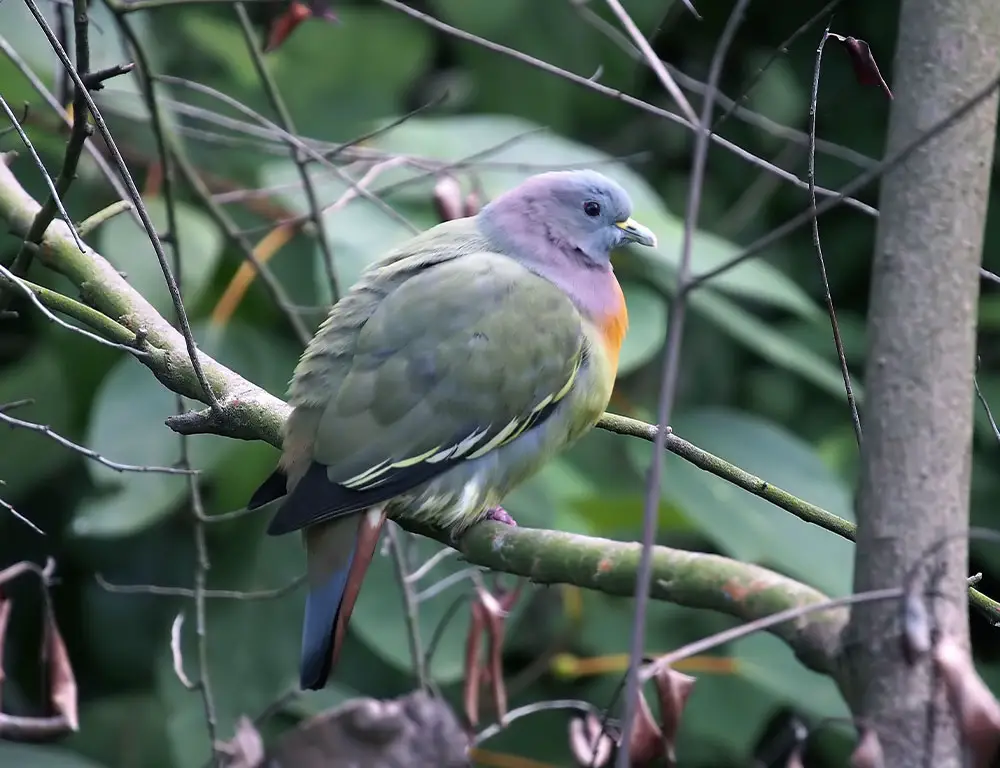
Common Characteristics Of Pink-Necked Green Pigeons
The Pink-necked Green Pigeon (Treron vernans) is a captivating bird species found in the lush tropical forests of Southeast Asia, renowned for its vibrant plumage and unique characteristics. Here are some common characteristics of this species:
Physical Characteristics Of Pink-Necked Green Pigeon
Pink-necked green pigeons (Treron vernans) are striking birds native to Southeast Asia, known for their vibrant plumage and distinctive features. Here are seven physical characteristics that distinguish this species:
Plumage
The Pink-necked green pigeon exhibits a unique coloration, with males displaying a predominantly green body contrasted by a striking pink patch on the neck and chest.
Conversely, females have a more subdued appearance with a grayish-green plumage and less prominent pink coloring.
Size
These pigeons are relatively small, measuring around 24 to 27 centimeters in length, with a wingspan of approximately 30 to 33 centimeters. Despite their small stature, they possess a robust build with rounded wings and a short tail.
Bill
Pink-necked green pigeons have a distinctive short and stout bill, adapted for feeding on fruits and seeds. The bill is typically dusky, blending seamlessly with the surrounding plumage.
Eyes
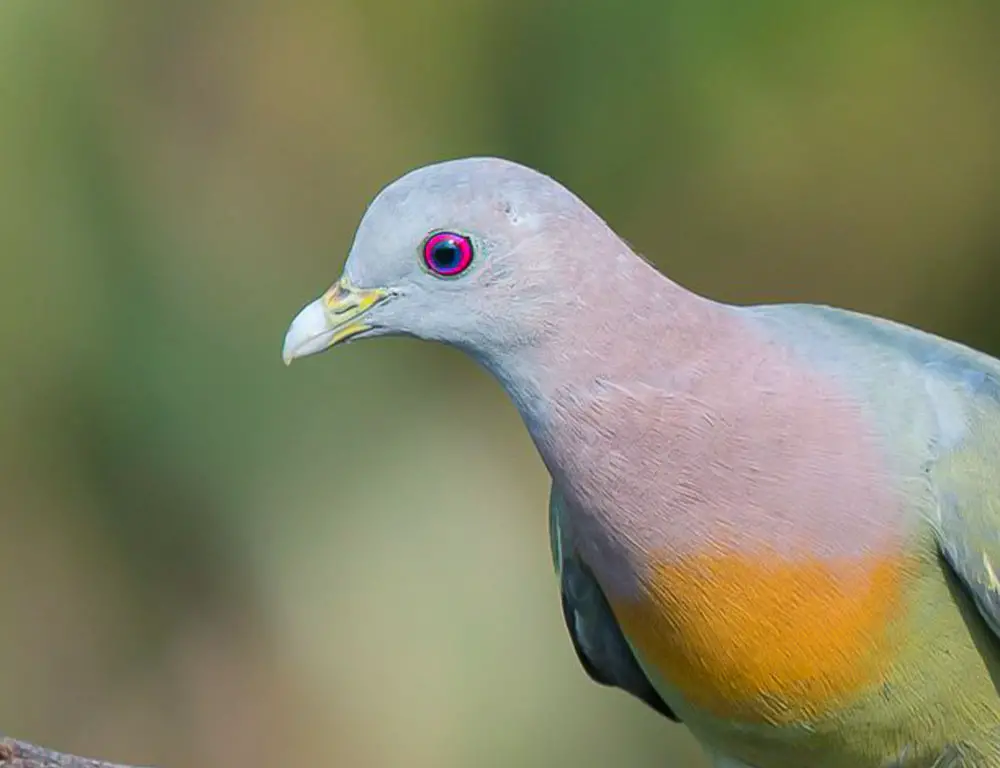
Their eyes are large and round, positioned on either side of their head, providing excellent binocular vision. The iris is typically a deep reddish-brown, adding to their striking appearance.
Legs and Feet
The legs of Pink-necked green pigeons are relatively short but sturdy, adapted for perching and hopping among branches. Their feet have strong claws, allowing them to grip onto branches securely while feeding or resting.
Tail
The tail of these pigeons is short and squared-off, with a slightly rounded tip. While perched, they often hold their tail fanned out, displaying the subtle iridescent hues of their feathers.
Sexual Dimorphism
One notable physical characteristic of Pink-necked green pigeons is the sexual dimorphism in plumage coloration. Males exhibit the distinctive pink patch on their neck and chest, while females have a more subdued greenish-gray plumage without the prominent pink coloring.
Distribution And Habitat
Pink-Necked Green Pigeons are commonly found in Southeast Asia’s dense forests, mangroves, and wooded areas, including countries such as Malaysia, Indonesia, Thailand, and the Philippines. They prefer habitats with abundant fruit-bearing trees and dense vegetation.
Reproduction
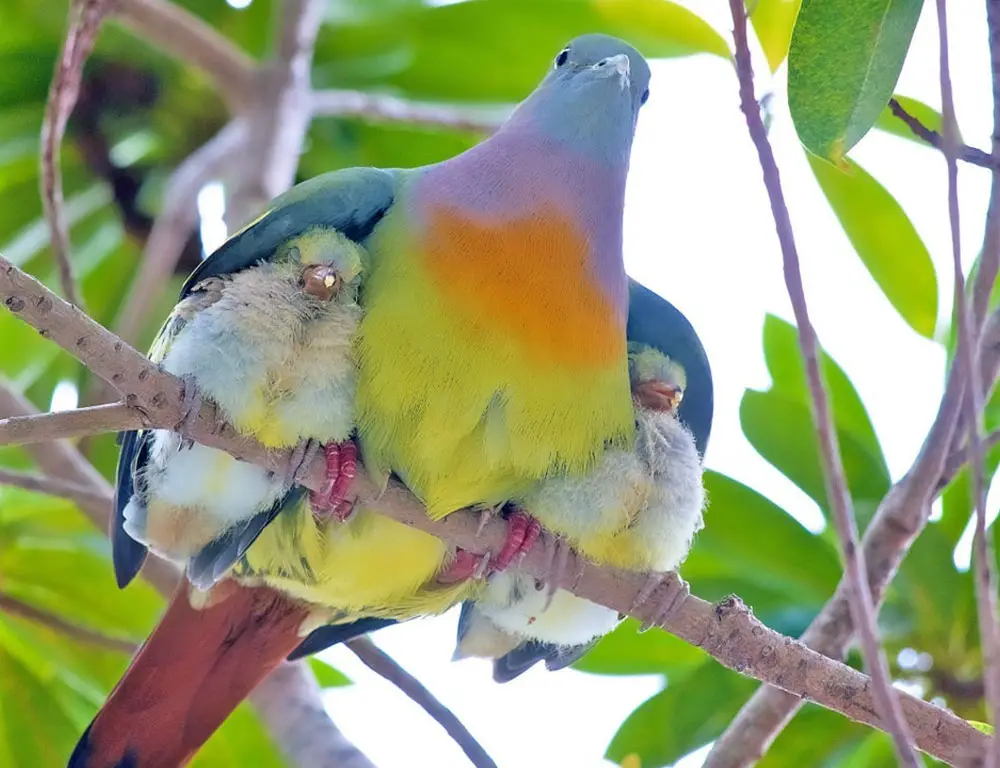
During the breeding season, which typically occurs during the wet season, Pink-Necked Green Pigeons form monogamous pairs and build simple nests made of twigs and leaves in the branches of trees.
Females lay one or two eggs per clutch, and both parents participate in incubating the eggs and raising the chicks.
Lifespan/Longevity
The average lifespan of Pink-Necked Green Pigeons in the wild is around 5 to 7 years. However, individuals in captivity may live longer, with some reaching up to 10 years or more with proper care.
Communication And Perception
Pink-Necked Green Pigeons communicate with each other through a variety of vocalizations, including soft cooing calls, which serve to maintain contact within a flock and during courtship displays.
They also rely on visual cues and keen perception to navigate their forest habitat and locate food sources.
Status
The Pink-Necked Green Pigeon is generally considered to be of least concern regarding conservation status, as it has a relatively stable population and a wide distribution range across its native habitat in Southeast Asia.
Food Habits
These pigeons are primarily frugivorous, feeding on various fruits, berries, and seeds found in their habitat. Their diet plays a crucial role in seed dispersal and helps maintain the biodiversity of plant species in the forest ecosystem.
Behaviour And Ecology
Pink-Necked Green Pigeons are arboreal birds, spending most of their time perched in trees and shrubs where they can forage for food and roost safely away from ground predators.
They are often observed in small flocks, especially during feeding and roosting periods, and may engage in social grooming behaviors.
The Pink-Necked Green Pigeon exhibits a range of common characteristics that reflect its adaptation to life in the tropical forests of Southeast Asia.
From its distribution and habitat preferences to its reproductive behavior, food habits, and social dynamics, each aspect of its biology contributes to its ecological importance and survival in its natural environment.
Taxonomy
Here’s a simplified table outlining the taxonomy and classification of the Pink-Necked Green Pigeon (Treron vernans):
| Taxonomy Level | Classification |
| Kingdom | Animalia |
| Phylum | Chordata |
| Class | Aves |
| Order | Columbiformes |
| Family | Columbidae |
| Genus | Treron |
| Species | Treron vernans |
The Pink-Necked Green Pigeon belongs to the Animalia kingdom, Chordata phylum, Aves class, Columbiformes order, Columbidae family, Treron genus, and its specific species name is Treron vernans.
This classification reflects its evolutionary relationships and taxonomic placement among other bird species.
Nesting Habit
Here’s a simplified table outlining the nesting habits of the Pink-Necked Green Pigeon (Treron vernans):
| Nesting Habit | Description |
| Nest Type | Simple platform nests made of twigs, leaves, and branches are constructed in the branches of trees. |
| Nest Material | Twigs, leaves, and branches are the primary materials used in nest construction, often lined with softer materials. |
| Nest Placement | Nests are typically situated in the canopy of trees, providing protection and concealment from predators. |
| Breeding Season | Breeding season usually coincides with the wet season, varying slightly across different regions. |
| Clutch Size | Typically consists of one or two eggs per clutch. |
| Incubation Period | Both parents participate in incubating the eggs, which hatch after about two weeks. |
| Parental Care | Both male and female parents share responsibilities in incubating the eggs and caring for the hatchlings. |
This table provides an overview of the nesting habits of the Pink-Necked Green Pigeon, including nest type, material, placement, breeding season, clutch size, incubation period, and parental care.
These nesting behaviors reflect the species’ reproductive strategies and adaptation to its natural habitat.
Description On The Ranging Map Of A Pink-Necked Green Pigeon
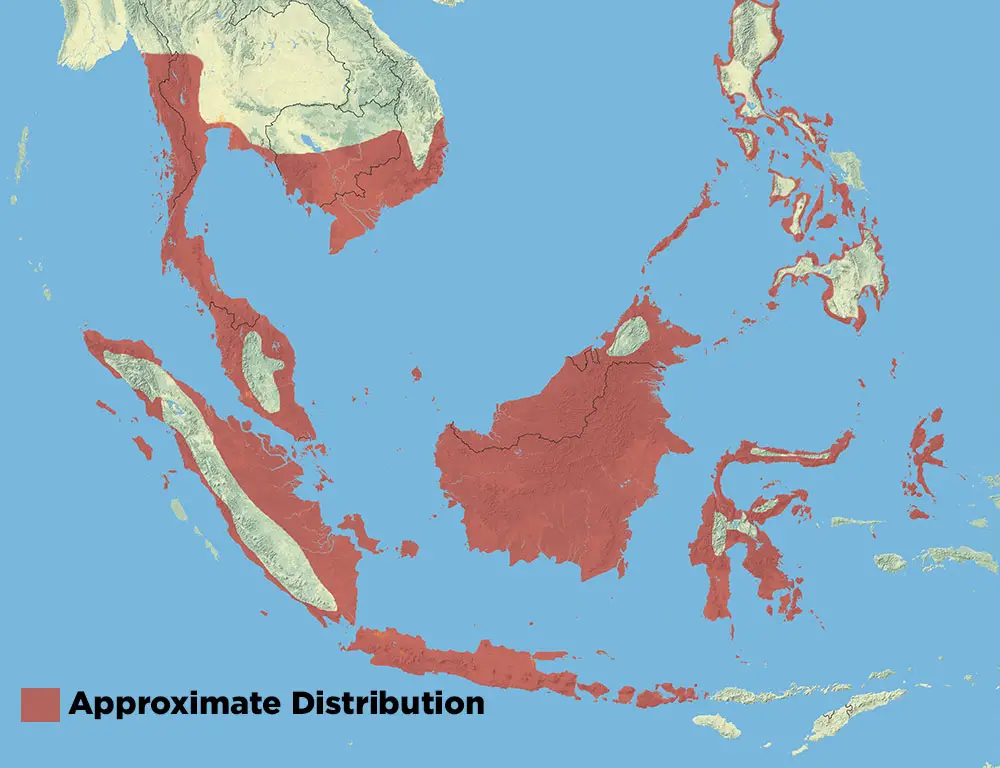
The ranging map of the Pink-Necked Green Pigeon (Treron vernans) illustrates the distribution of this captivating bird species across the lush tropical forests of Southeast Asia.
This species can be commonly found in countries such as Malaysia, Indonesia, Thailand, and the Philippines, inhabiting various habitats, including dense forests, mangroves, wooded areas, and even urban parks and gardens.
Within its range, the Pink-Necked Green Pigeon demonstrates a preference for habitats with abundant fruit-bearing trees and dense vegetation, where it can forage for food and roost safely away from ground predators.
While primarily sedentary, Pink-Necked Green Pigeons may exhibit localized movements in response to changes in food availability or habitat conditions.
Conservation efforts aimed at preserving the natural habitats of this species are crucial for ensuring its continued presence and ecological contribution in the rich biodiversity of Southeast Asia.
How Do You Tell The Difference Between Male And Female Pink-Necked Green Pigeons?
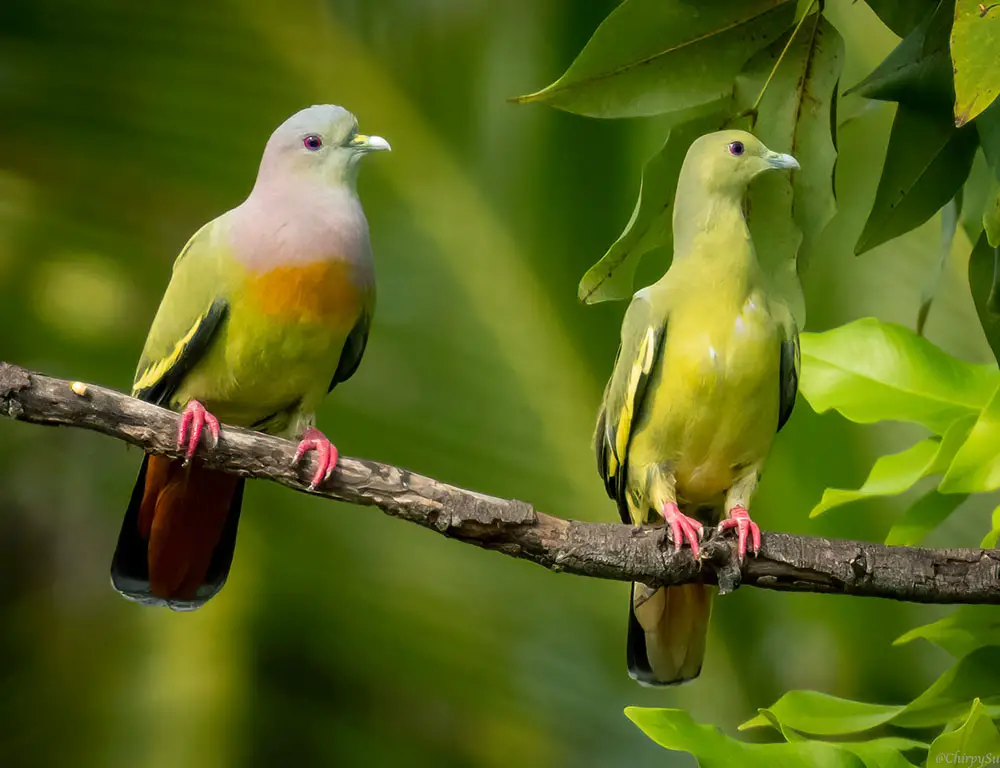
Distinguishing between male and female Pink-Necked Green Pigeons (Treron vernans) can be challenging due to their subtle differences in plumage. However, several key characteristics can help differentiate between the two genders.
Here are seven ways to tell them apart:
Plumage Coloration
The most noticeable difference is in plumage coloration. Males exhibit a vibrant green body with a distinct pink patch on the neck and chest, while females have a more subdued greenish-gray plumage without the prominent pink coloring.
Pink Patch Size
In males, the pink patch on the neck and chest tends to be larger and more vivid, extending further down the chest than in females, where the pink patch is often smaller and less intense.
Head Coloration
Males may have a slightly darker shade of green on the head than females, although this distinction can be subtle and may vary among individuals.
Wing Coverts
In some cases, males may have darker wing coverts than females, with a slightly more iridescent sheen to their feathers.
Eye Color
Males may have a slightly brighter or more intense eye coloration compared to females, with a reddish-brown iris that stands out against the green plumage.
Size And Shape
While not always reliable for distinguishing between the sexes, males may appear slightly more extensive and more robust than females, with a more pronounced chest and neck.
Behavior
During the breeding season, males may exhibit more territorial behavior, including vocalizations and displays, while females may be more focused on nest building and incubating eggs.
While male and female Pink-Necked Green Pigeons share many similarities in appearance, careful observation of plumage coloration, size, eye color, and behavior can help distinguish between the two genders.
These subtle differences contribute to the overall beauty and complexity of this species.
Conclusion
The Pink-Necked Green Pigeon stands as a vibrant testament to the rich biodiversity of Southeast Asia’s tropical forests.
Through its striking plumage, unique characteristics, and ecological roles as a frugivorous bird, this species contributes to the beauty and resilience of its natural habitat.
As we strive to conserve the forests that support the Pink-Necked Green Pigeon and other wildlife, we also acknowledge the importance of raising awareness about its conservation needs and fostering appreciation for its cultural and ecological significance.
Let us continue to cherish and protect the Pink-Necked Green Pigeon as a symbol of biodiversity and natural heritage in the vibrant tapestry of Southeast Asian ecosystems.